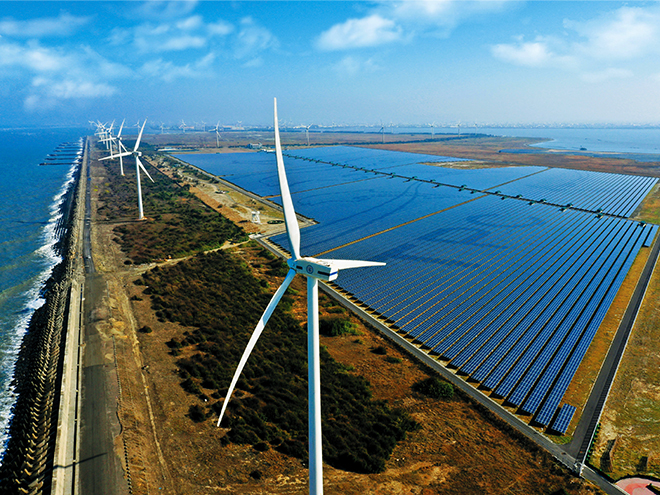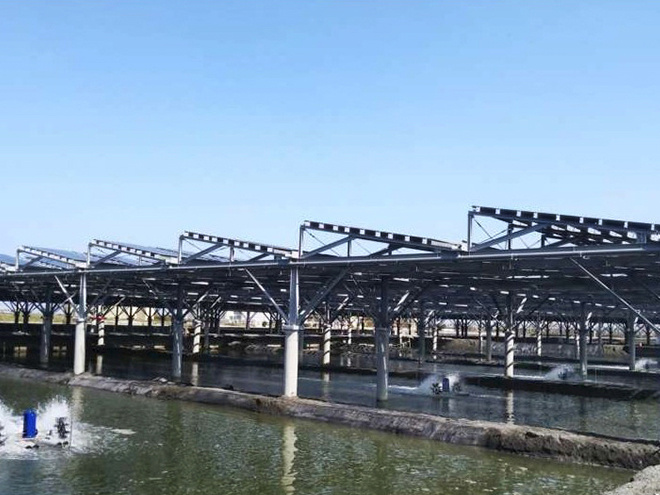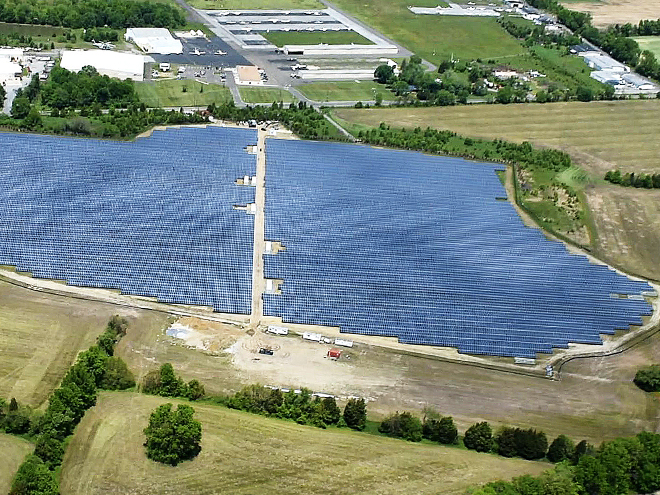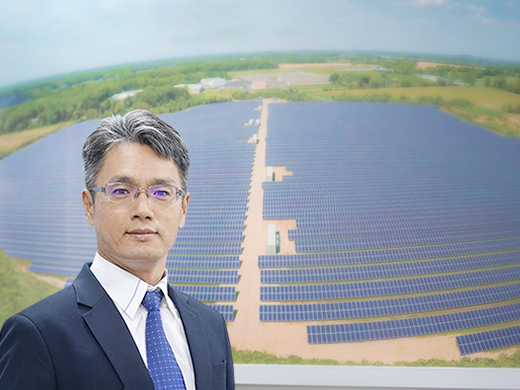Innovation
企業創新
ECOVE Assists to Achieve Energy Transformation & Realize Carbon Neutrality: Development of Large-scale Ground-mounted Solar Power Plants
A leader in Taiwan's circular economy, ECOVE Environment Corporation (ECOVE) has grasped the global trends and opportunities for green energy development. Having invested in the development of the solar energy industry since 2011, ECOVE's total solar power capacity has reached 100MW over the last decade. The company has further expanded overseas to become one of the few leading enterprises that has successfully invested overseas. While developing the global market and competing for opportunities related to carbon neutrality, ECOVE has also actively committed to the developments and investments in large-scale ground-mounted power plants. These efforts will help accelerate fulfilling the government's target in achieving 20GW of solar power by 2025.
Diversifying Energy Sources to Achieve Carbon Neutrality
Countries around the world have proposed net zero emission goals in response to climate change. Developing clean, renewable energies in place of traditional high-carbon emitting fossil fuels/energy sectors has now become a global trend in energy development in order to realize carbon neutrality. Besides businesses voluntarily initiating green supply chains and governments specifying renewable energy obligations for major power consumers, major markets, including the United States, have also actively formulated carbon reduction and renewable energy development goals, thereby promoting the continued rising demand for renewable energies. As for Taiwan, under the energy diversification policy and objective, the ratio of renewable energy will reach 20% by 2025. In particular, the goal of 20GW solar power installation capacity is the most active and most feasible. And the development of large-scale ground-mounted solar power plants will accelerate the realization of this goal. Having over a decade of investment and execution experiences in solar power, ECOVE is committed to actively developing the domestic market and increasing green energy generation. In addition, the company has also seized key elements in the development process by participating in policy conferences and maintaining dialogues with external parties over the past two years. By integrating external and internal resources, ECOVE has formulated standardized construction processes for large-scale ground-mounted power plants. This article aims to provide an overview to the development of large-scale ground-mounted solar power plants.
Stringent Evaluation for Development of Large-scale Ground-mounted Power Plant
Taiwan is a small and densely populated country with limited land resources. To achieve the 20GW solar power target by 2025, the Executive Yuan needs to accelerate the development of large-scale ground-mounted power plants. Compared with small and medium-sized roof-mounted solar power stations with comprehensive development laws and processes and simpler environments already in place, the development of ground-mounted power plants is more challenging, labor-intensive, time consuming, and involves the government's urban planning and the land use regulations by the Council of Agriculture, which are rather complex and with strict limitations. To successfully develop a large-scale ground-mounted power plant, one must confirm with the competent authority the land use and development rules, and complete various processes, including acquisition of land use rights, confirming the distribution feeder capacity and grid connection method with Taiwan Power Company (Taipower), setting up an electric utility, altering or acquiring the permission for land use, and communicating with the local government/residents before construction could begin and grid connection could be completed. The entire process would take at least 2-3 years. Since each phase is correlated with the next, the developer must undergo stringent evaluation before the entire process is launched. Otherwise, the smallest problem could affect investment revenue, whereas major problems could result in project failure.

Large-scale ground-type solar power plant in Taiwan (Photo credit: Taipower).
Three Critical Factors for Successful Project Implementation
To promote the development of large-scale ground-mounted power plants, the government has utilized lands with established usage for solar power plant setup. This helps to revitalize land and creates synergistic benefits. Presently, designated lands such as severe land subsidence zones, unfavorable farming zones, agrivoltaic farms, and fishery and electricity symbiosis zones have gradually been chosen to install solar power plants, which help ease restrictions on the use of farm land. At the same time, relevant management rules have been formulated with the application process having been simplified to attract business investments. The following is a summary on the current regulations for agrivoltaic farms, and fishery and electricity symbiosis zones, land integrations, issues for distribution feeders, as well as challenges facing developers.
I.Agrivoltaic Farms The planning of agrivoltaic farming projects is treating solar power plants as an ancillary facility on farm lands. However, farmers are required to guarantee a certain amount of crop yield each year, provide proof of production and sales, and receive an audit. The farmers are thus hesitant about engaging in such projects due to the lack of management resources and risks for making compensations. As for the developers, these projects involve national spatial planning and conservation, and deforestation for solar power construction has been a much debated issue. In July 2020, the Council of Agriculture has amended the "Guidelines in Reviewing Farmland Use" to specify the conditions for development and authorization rights for review and approval, which significantly reduced the development opportunities and indirectly led to enormous losses for many developers. Additionally, the government has recently introduced various regulations including the outflow control and environmental and social review mechanisms, leading to delayed development scheduling and causing developers to sustain immeasurable losses as they were unable to achieve the agreed upon electricity wholesale rates. This made relevant project promotions even more challenging. II.Fishery and Electricity Symbiosis Due to the ineffective promotions for agrivoltaic farms, the government, after taking in the opinions from all parties and building experiences, has changed tactics last year to solve the issue with falling achievement rates. By forming inter-departmental collaboration involving the Ministry of Economic Affairs (MOEA), Council of Agriculture, and the Ministry of the Interior, the government has actively promoted the less controversial fishery and electricity symbiosis projects by simplifying administrative procedures and collaborating with local governments. Founded on the core mission of "prioritizing fishery while treating green energy as a value-added service," the fishery and green energy investments have been combined to promote the upgrading of the fishery industry and its sustainable development, with the goal of creating local job opportunities, optimizing aquaculture technologies and environment, and sustainable land development and use, hence promoting synergistic growth between the fishery industry and green energies. The fishery and electricity symbiosis zone is a low-density development, and to resolve issues between stakeholders during the development process, the government has led the formation of an "environmental and social review mechanism." By taking inventories of less-controversial aquaculture zones before construction and evaluating the environmental impacts of building solar power plants, response measures can be proposed early on. Moreover, external concerns are also mediated through sufficient communications to ensure the power plants' coexistence and co-prosperity with the society and the environment. After eliminating controversial sites, certain designated advance sites that allow developers to build are set up. Developers can also evaluate the sites excluded in the advance sites based on the aforementioned review mechanism, which helps to reduce development risks while also relieving the local governments' burden on conducting reviews. III. Land Integration In terms of obtaining the right for land development, the developer will need to consider whether to negotiate with the land owner in person or to commission local land developers or agents to achieve land integration, regardless of the type of development zone the developer chooses. Sufficient communications and mediations with the local residents and stakeholders are also required. At the same time, to avoid protests and to ensure the smooth, unimpeded implementations of the project, the developer should reach a consensus with and support from the local community by proposing community contribution programs or environmental friendly projects that address local needs. IV. Distribution Feeder of the Electric Grid After solving the aforementioned legal and land acquisition problems, the developer should also consider whether the feeder capacity of the local electric grid is sufficient. This is because an overloading problem from existing distribution feeders has already surfaced in response to the grid connection needs from large-scale power stations. Though the MOEA has requested Taipower to accelerate capacity expansion as soon as possible, the current load capacity is still insufficient. Presently, the common industry practice is to set up private booster stations and to connect to neighboring substations along the existing roads. However, negotiations with land owners to obtain the use right will still be necessary if the electric circuit does not border any existing road and needs to go through private land. This also adds to the complexity and risk of the operation. To this end, Taipower has recently formulated principles for applying for, building, and sharing booster stations to help reduce the burden on the developers. Going forward, this will assist in accelerating the promotion of project developments.

A demonstration site for fishery and electricity symbiosis that integrates aquaculture with solar power (Photo credit: Fisheries Research Institute).
Future Prospects of Large-scale Ground-mounted Power Plants
At ECOVE, we are committed to renewable energy development and investment, and with ample experiences in investing, developing, constructing, and operating solar power stations, we have successfully tapped into green energy transaction businesses to assist corporate users in attaining carbon neutrality. In view of the growing maturity of the domestic market for large-scale ground-mounted power plants, ECOVE has targeted relevant mainstream projects in fishery and electricity symbiosis, and actively seeks for suitable project development opportunities. We hope to take advantage of the synergy of CTCI Group and to complete each and every phase of the project, from design planning, construction, to operation. We also plan to collaborate with both domestic and large-scale foreign investment partners to achieve co-prosperity by assisting enterprises and the government to increase the development and utilization of green energy, and to achieve carbon neutrality and sustainable development. Furthermore, we have worked with a US-based local partner to invest in Lumberton development project in New Jersey, the U.S. back in 2011 and have successfully launched this large-scale ground-mounted power plant in 2016 after overcoming various difficulties and challenges. The plant has been operating for over 5 years and its investment benefits have exceeded expectations, which also sets a positive example and basis for future investments. Going forward, ECOVE will continue to actively reach out to large-scale solar power projects in the US and other major markets, hoping to continue increasing the scale of our investments overseas.

An overview of ECOVE Lumberton project in the US.

